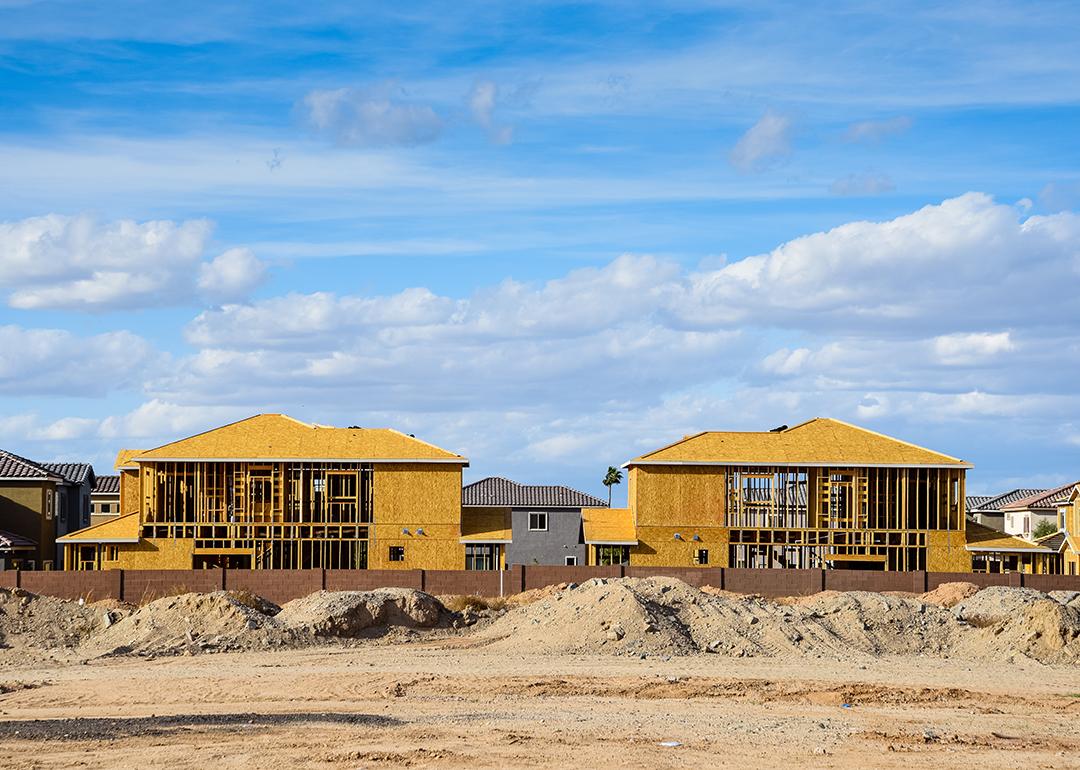
Build-to-rent boom: 110,000+ single-family rentals under construction across U.S., with Texas, Arizona, and Florida in the lead
This story was produced by Point2Homes and reviewed and distributed by Stacker.
Build-to-rent boom: 110,000+ single-family rentals under construction across U.S., with Texas, Arizona, and Florida in the lead
For homebuyers who are still on the fence about buying, renting the American dream for the time being could be the next best thing. As home prices continue to increase, down payment amounts remain discouraging and high mortgage rates keep many on the sidelines, the build-to-rent, or BTR, sector offers renters not just options, but peace of mind.
The flexibility of renting, coupled with extra perks such as community amenities and covered maintenance, make single-family homes in build-to-rent communities all the more desirable. As a result, the build-to-rent market is growing rapidly, with occupancy rates holding steady at 95% and construction activity surging across major metros and states. This is good news for renters looking for more spacious homes and amenities that are more suited for family life and remote work. As the suburb regained some of its former popularity during and after the pandemic, build-to-rent communities started taking off, providing renters with roomy homes, desirable backyards, and up-to-date amenities that cities just can't offer.
According to the most recent Point2Homes build-to-rent report, more than 110,000 single-family rental homes in 613 BTR communities are currently under construction nationwide. Whether these projects broke ground recently or a few years ago, many will soon be ready to hit the market, expanding existing inventory by a robust 53.5% when completed.
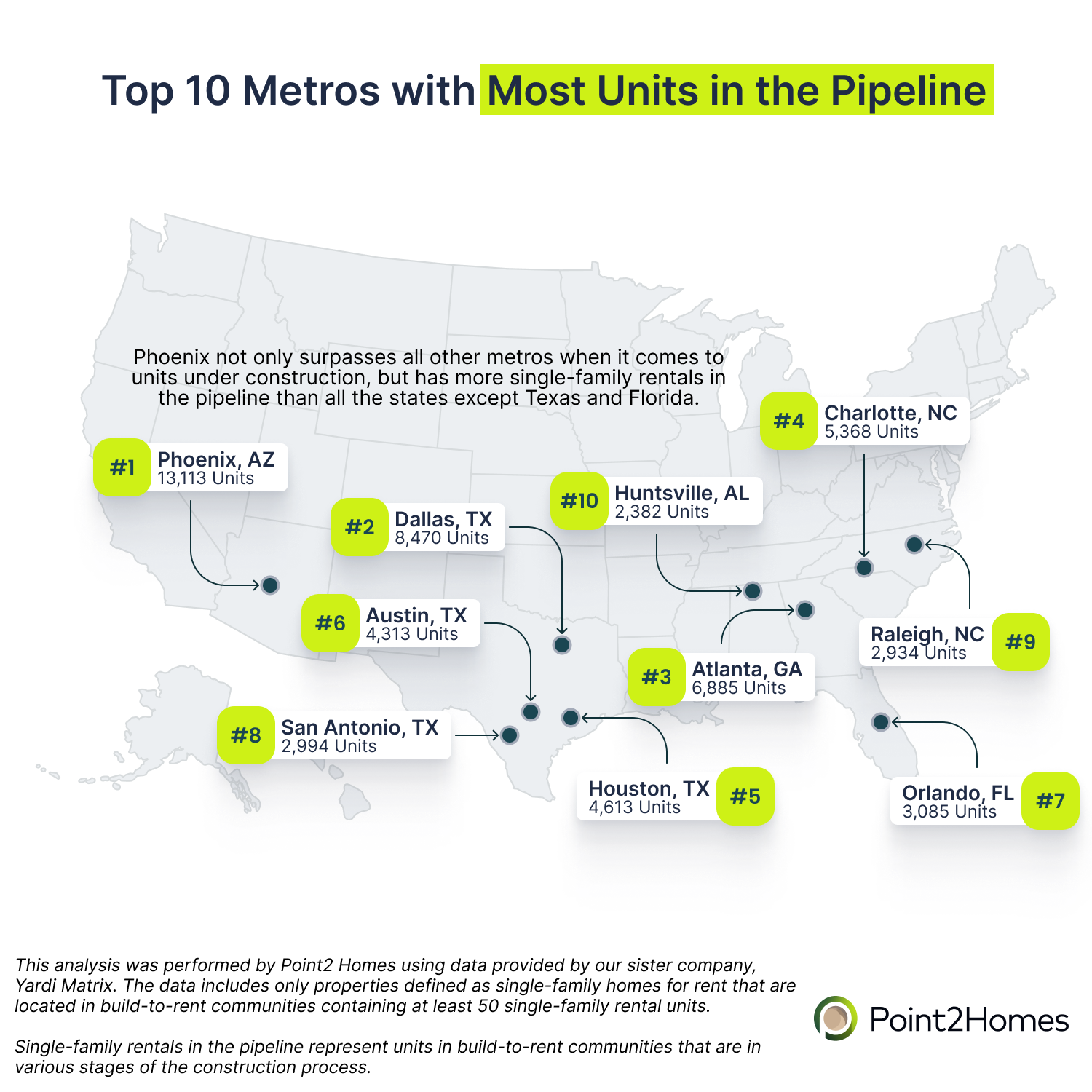
15 Metros Have 1,500+ Build-to-Rent Homes Underway
Phoenix leads the charge with the most ambitious numbers, and Dallas and Atlanta complete the podium.
While Texas leads the nation in overall construction, Phoenix dominates at the metro level. Arizona's capital remains a hotbed for build-to-rent expansion due to its strong job market, presence of Fortune 500 companies, and a growing focus on sustainability. These are the main factors that attract new residents, fueling rental demand and keeping developers busy.
With a total of 13,113 single-family rentals in the pipeline, Phoenix surpasses every other metro and even most states, except for Texas, Arizona itself, and Florida. Within the metro, the city proper is responsible for nearly 3,000 of the 13,000+ units underway, with Buckeye, Surprise, Goodyear, and Queen Creek each adding between 1,000 and nearly 2,000 new rental houses. Additionally, two other Arizona metros make an appearance, although they are trailing way behind other markets: Tucson has 659 units under construction and Flagstaff is adding 200 more.
Dallas follows as the second most active metro, with 8,470 single-family rentals under development. Given Texas's leadership in BTR construction, it's obvious more markets from the state made it into the top 10 best metros for single-family rental communities under construction. The other major metros in the state that are also seeing significant activity: Houston is adding 4,613 units, Austin 4,313, and San Antonio nearly 3,000. The state's favorable tax policies, economic diversity, and relatively affordable housing market contribute to the surge in rental home development.
Beyond Phoenix and Dallas, five other metros make up the top 10 for BTR construction. Atlanta ranks third, with developers working on 6,885 single-family rentals across 43 new communities. The city's population growth and strong business climate keep rental demand high, making it a prime location for BTR expansion.
The Southeast is well-represented in the top 10, with Charlotte, NC; Orlando, FL; Raleigh, NC; and Huntsville, AL, each adding between 2,000 and 5,368 new units. These metro areas benefit from business-friendly policies, strong job markets, and the continued demand for spacious rental homes.
Aside from the 10 markets leading the way due to their impressive number of single-family rentals in the pipeline, 14 more metros are looking at more than 1,000 houses for rent that are in various stages of development. This means renters in these areas will soon have a better chance of finding the right rental for their needs. The pandemic significantly influenced these trends by shifting rental demand away from small apartments in expensive cities to larger homes in more affordable secondary markets. Rising single-family home prices and increased remote work opportunities further fueled interest in single-family rentals, reinforcing the sector's momentum.
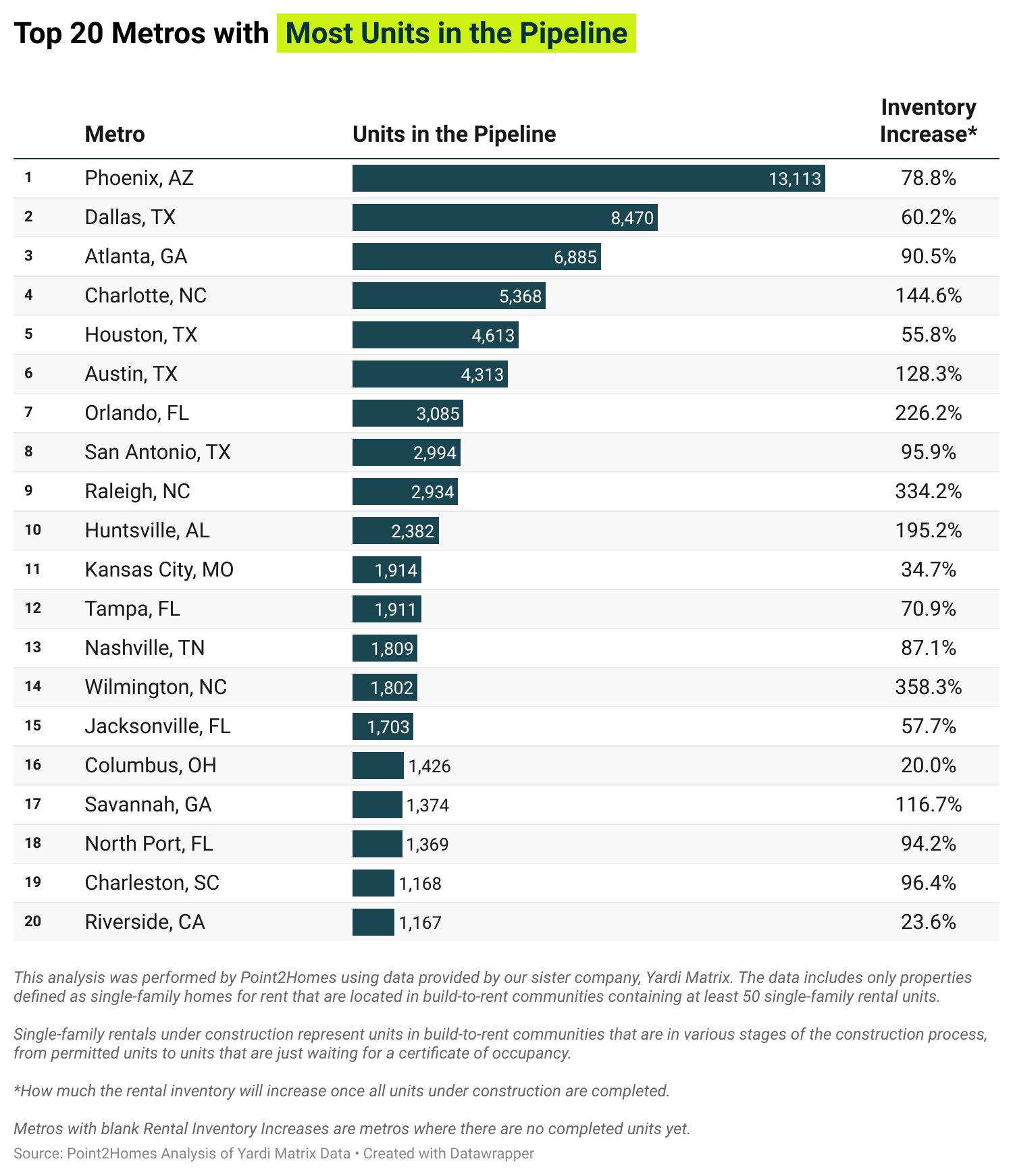
How the Pandemic Shifted Rental Demand to Single-Family Homes
The pandemic significantly influenced these trends by shifting rental demand away from small apartments in expensive cities to larger homes in more affordable secondary markets. Rising single-family home prices and increased remote work opportunities further fueled interest in single-family rentals, reinforcing the sector's momentum.
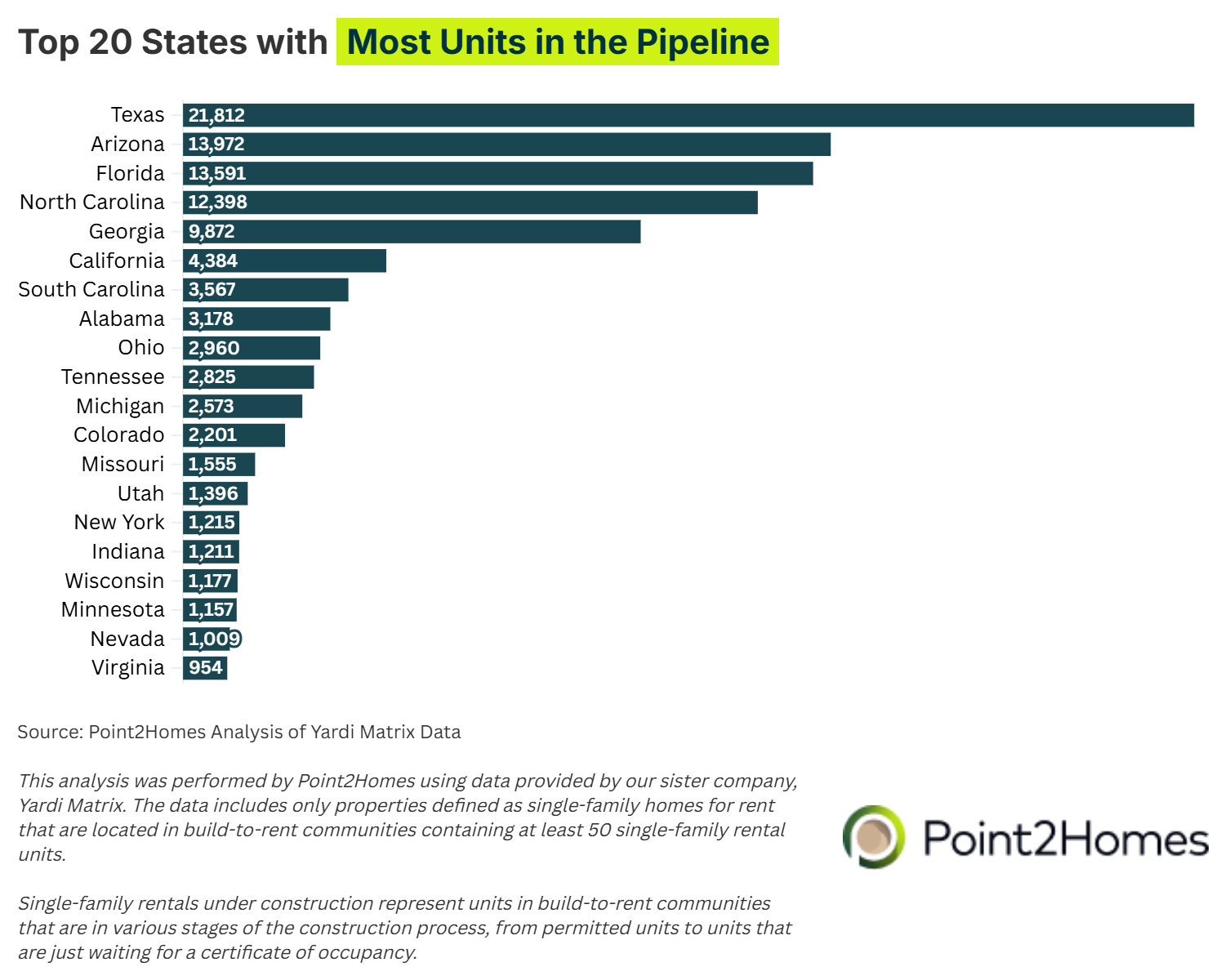
In the Five States With the Most Units Under Construction, BTR Supply Will Increase More Than 50% Upon Delivery
Also, in the seven states that are really ramping up BTR development, supply will jump 125% to 255%.
Just like Phoenix is way ahead of the pack at the metro level, Texas is in the lead at the state level, outshining every other market by a generous margin. With 21,812 single-family rentals under construction, The Lone Star State has the highest number of single-family rentals in the pipeline. Arizona and Florida follow with nearly 14,000 units each, while North Carolina and Georgia round out the top five. Developers in these states are actively expanding the BTR market, offering new communities with modern amenities designed to enhance renters' lifestyles.
Typically, coastal states and urban hubs attract the highest rental demand due to job opportunities and economic growth. However, given that the suburbs and metro areas have more affordable land and more forgiving zoning rules, developers are now extending their focus beyond dense city centers to build spacious, affordable rental communities in metros and suburban areas.
North Carolina is the standout among the top five states, expecting a remarkable 152% increase in rental inventory once current projects are completed. Similarly, Texas's nearly 22,000 new single-family rentals will boost the state's total inventory by 70%.
Several other states will experience significant percentage-based growth when the single-family rentals currently under construction reach renters. Even if the overall unit numbers are lower, most probably because house rentals are a newer addition to their housing options, the fact that these states are joining the BTR bandwagon shows the growing strength of this housing sector. Nebraska, Rhode Island, Delaware, New Hampshire, North Carolina, New Mexico, and Virginia all expect rental supply increases of more than 100%, with Nebraska leading at 255%.
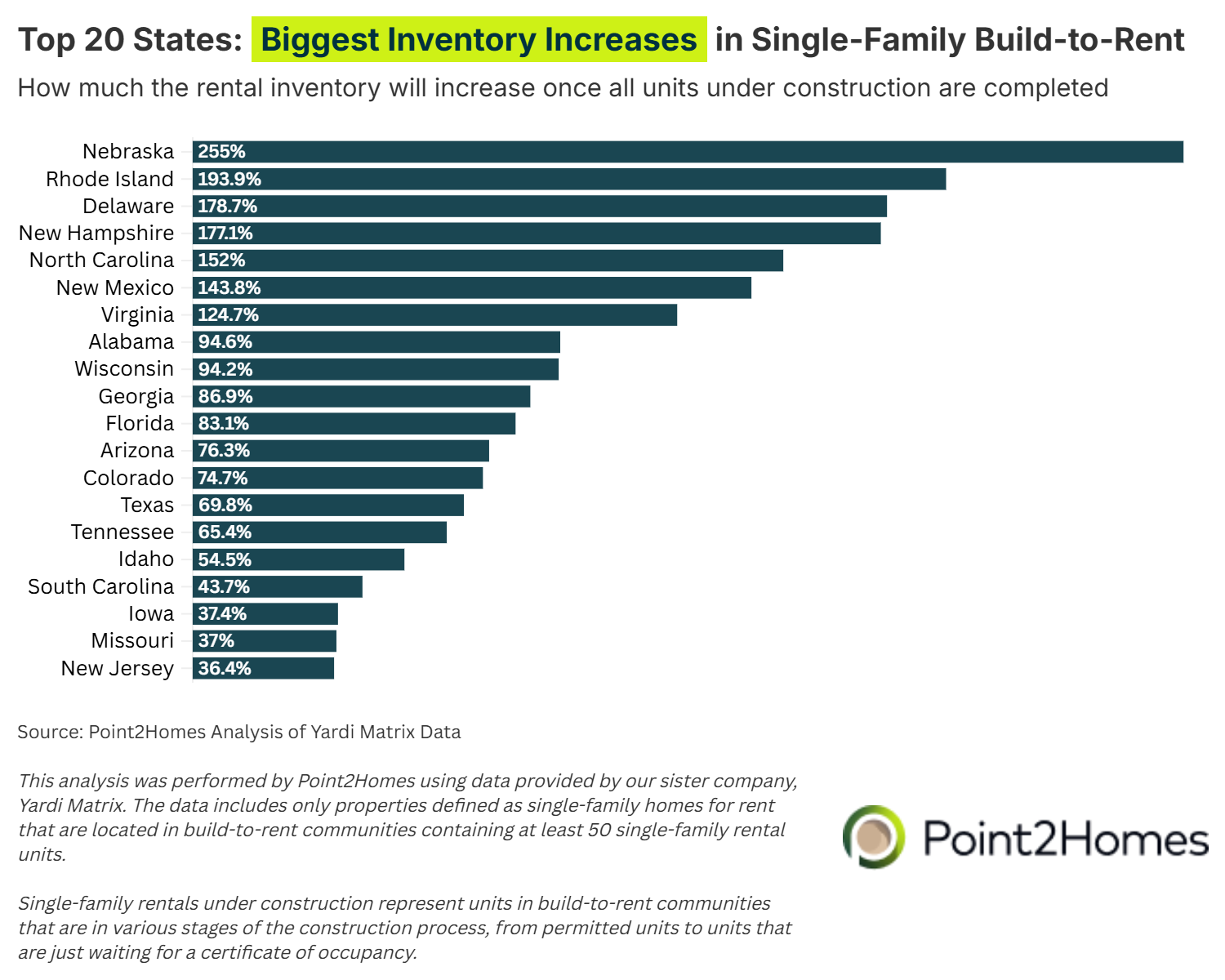
The Build-to-Rent Boom Is Reshaping U.S. Housing
The BTR sector continues to thrive by providing an attractive alternative for renters who need more space but aren't ready to buy. Developers are strategically shifting away from high-cost urban centers to suburban areas with more streamlined zoning and permitting processes. This results in faster construction timelines, more affordable options, and access to high-quality rental homes.
Although single-family rental activity might slow down in the future, construction activity remains strong. A recent Yardi Matrix report noted that the sector faces challenges such as rising material, increasing labor costs, and higher construction financing rates. However, with demand for spacious rentals holding steady, the BTR market is well-positioned for continued expansion.
According to Doug Ressler, senior analyst & manager of business intelligence at Yardi Matrix, affordability is just one of the advantages that the single-family build-to-rent sector offers:
"As urban areas become more congested and expensive, there's a growing trend towards suburban living. BTR properties in suburban areas offer more space and affordability while maintaining connectivity to urban centers.
More and more BTR residents consider themselves renters by preference compared to 2023 (36% in 2024 vs. 27% in 2023). The biggest hurdle to buying a home for BTR residents is high mortgage rates, so BTR homes provide an affordable solution in today's increasingly expensive housing market.
On average, renting a BTR unit is cheaper than buying a starter home. Recent reports indicate that renting can save one around $1,000 per month compared to buying. This is largely due to high mortgage rates and elevated home prices."
For renters reaching new life milestones and looking to upgrade their living spaces and amenities without the commitment of homeownership, the growing BTR supply offers promising options. As more communities continue to be completed, more renters across the U.S. will have access to high-quality, single-family rental homes that fit their needs and their budgets, as well.
Methodology
Point2Homes.com is a real estate listing portal for rental homes across the United States. Part of Yardi Systems, Point2Homes covers housing trends and news through comprehensive studies that draw from internal data, public records, governmental sources, and online research.
This study is exclusively based on data related to build-to-rent communities containing at least 50 single-family rental units.
This analysis was performed by Point2Homes using data provided by our sister company, Yardi Matrix. The data includes only properties defined as single-family homes for rent that are located in build-to-rent, professionally managed communities in the markets covered by Yardi Matrix research. Data for some markets may not be available and data for the locations included in the analysis may be subject to change. This analysis does not include other types of single-family rentals that are not located in build-to-rent communities.
Build-to-rent communities are defined by Yardi Matrix as communities where at least 50% of the units fit one of the following criteria: (1) They do not share any walls with other units, or (2) they have shared walls, but do not have neighbors above/below or have a direct-access garage.
For the purposes of this study, we considered "units in the pipeline in 2025" as all units that are (1) currently under construction and (2) currently planned (units that have already been permitted).
"Units under construction" hadn't received a certificate of occupancy by the end of December 2024 or are currently being built. Under-construction data may be incomplete and is subject to change. "Planned units" are units for which all zoning issues have been resolved and the appropriate legal institution has signed off on and approved the development proposal submitted.



